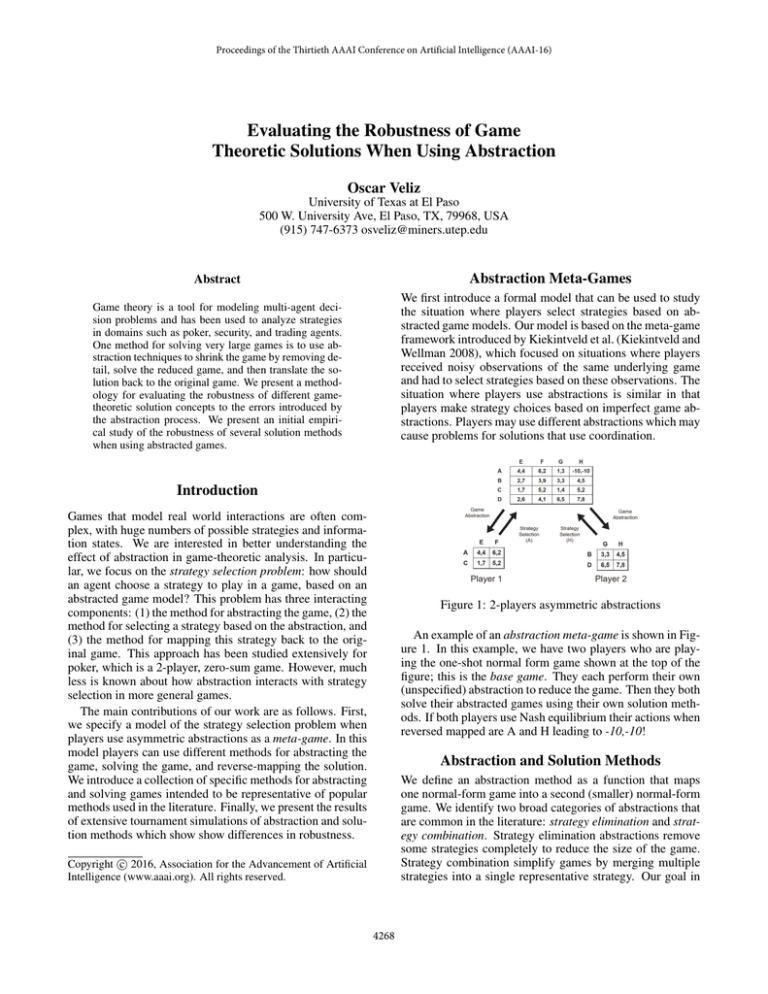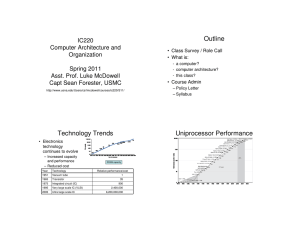
Proceedings of the Thirtieth AAAI Conference on Artificial Intelligence (AAAI-16)
Evaluating the Robustness of Game
Theoretic Solutions When Using Abstraction
Oscar Veliz
University of Texas at El Paso
500 W. University Ave, El Paso, TX, 79968, USA
(915) 747-6373 osveliz@miners.utep.edu
Abstraction Meta-Games
Abstract
We first introduce a formal model that can be used to study
the situation where players select strategies based on abstracted game models. Our model is based on the meta-game
framework introduced by Kiekintveld et al. (Kiekintveld and
Wellman 2008), which focused on situations where players
received noisy observations of the same underlying game
and had to select strategies based on these observations. The
situation where players use abstractions is similar in that
players make strategy choices based on imperfect game abstractions. Players may use different abstractions which may
cause problems for solutions that use coordination.
Game theory is a tool for modeling multi-agent decision problems and has been used to analyze strategies
in domains such as poker, security, and trading agents.
One method for solving very large games is to use abstraction techniques to shrink the game by removing detail, solve the reduced game, and then translate the solution back to the original game. We present a methodology for evaluating the robustness of different gametheoretic solution concepts to the errors introduced by
the abstraction process. We present an initial empirical study of the robustness of several solution methods
when using abstracted games.
Introduction
Games that model real world interactions are often complex, with huge numbers of possible strategies and information states. We are interested in better understanding the
effect of abstraction in game-theoretic analysis. In particular, we focus on the strategy selection problem: how should
an agent choose a strategy to play in a game, based on an
abstracted game model? This problem has three interacting
components: (1) the method for abstracting the game, (2) the
method for selecting a strategy based on the abstraction, and
(3) the method for mapping this strategy back to the original game. This approach has been studied extensively for
poker, which is a 2-player, zero-sum game. However, much
less is known about how abstraction interacts with strategy
selection in more general games.
The main contributions of our work are as follows. First,
we specify a model of the strategy selection problem when
players use asymmetric abstractions as a meta-game. In this
model players can use different methods for abstracting the
game, solving the game, and reverse-mapping the solution.
We introduce a collection of specific methods for abstracting
and solving games intended to be representative of popular
methods used in the literature. Finally, we present the results
of extensive tournament simulations of abstraction and solution methods which show show differences in robustness.
Figure 1: 2-players asymmetric abstractions
An example of an abstraction meta-game is shown in Figure 1. In this example, we have two players who are playing the one-shot normal form game shown at the top of the
figure; this is the base game. They each perform their own
(unspecified) abstraction to reduce the game. Then they both
solve their abstracted games using their own solution methods. If both players use Nash equilibrium their actions when
reversed mapped are A and H leading to -10,-10!
Abstraction and Solution Methods
We define an abstraction method as a function that maps
one normal-form game into a second (smaller) normal-form
game. We identify two broad categories of abstractions that
are common in the literature: strategy elimination and strategy combination. Strategy elimination abstractions remove
some strategies completely to reduce the size of the game.
Strategy combination simplify games by merging multiple
strategies into a single representative strategy. Our goal in
c 2016, Association for the Advancement of Artificial
Copyright Intelligence (www.aaai.org). All rights reserved.
4268
this paper is not to develop novel abstraction methods nor
to exhaustively evaluate the many existing techniques. The
first abstraction method we consider is TopN, which is representative of strategy elimination. It creates a smaller game
by selecting a subset of size N based on the overall payoff
sum for each action to form the abstracted game. Reverse
mapping strategies is trivial since a strategy in the abstracted
game is also a strategy in the original game.
The second abstraction method we use is KMeans, which
is representative of strategy combination. This method uses
k-means clustering to group strategies into clusters based
on the similarity of their payoffs in Euclidian distance. The
abstracted game payoffs are computed by taking the average
for all payoff outcomes in the cluster. The reverse mapping
assumes that all actions in a cluster have equal probability.
We consider several candidate solution methods for selecting strategies in abstracted games. All are based on
known solution concepts or simple heuristics for playing
games, and are intended to provide a diverse pool of plausible strategies. We use baseline agents such as Uniform
Random (UR) and common strategies like Nash Equilibrium (MSNE). It was also important to consider pessimistic
strategies like MaxMin which could be considered as robust.
We also include some sophisticated strategies like Quantal
Response Equilibria (QRE) (McKelvey and Palfrey 1995)
and Cognitive Hierarchies (CH) (Camerer, Ho, and Chong
2004) which originates in behavioral game theory.
Figure 3: TopN vs Kmeans in General Sum
Figure 3 shows the average payoffs for the different solution
methods in a tournament that combines agents using both
abstractions. We use only the best parameter settings for the
QRE, CH, and QLK agents. This tournament was run on
general-sum games, using a high level of abstraction (from
20 actions down to 5 actions). The results are quite striking
as TopN outperforms KMeans in every solution method.1
Conclusion
Our results demonstrate that using abstraction to solve
games is a complex endeavor, and the type of abstraction,
the solution methods used to analyze the abstracted games,
and the class of games all have a strong influence on the
results. Many of the strongest results using abstraction to
analyze large games (e.g., Poker) have focused on zero-sum
games. One of the most interesting observations from our
results is that abstraction often works very differently in
zero-sum games than it does general-sum games. In particular, solution methods based on finding Nash equilibrium
seem to work much better in zero-sum games than they do
in the other classes of games in our experiments. Another
important observation is that Nash equilibrium often does
not perform well in cases where abstraction is used as part
of the solution process. It is still effective when the games
are zero-sum, but in the other cases it was not robust to the
introduction of error based on game abstraction.
Results
We conducted many experiments to identify the best parameter settings for QRE, CH, and QLK agents and then
ran round robin tournaments on over 300 games, 18 unique
agents, and 4 levels of abstractions (including no abstraction). The full data set is difficult to visualize, so we present
selected subsets results to illustrate key points.
Acknowledgments
This material is based upon work supported by the National
Science Foundation under Grant No. IIS-1253950.
References
Camerer, C. F.; Ho, T.-H.; and Chong, J.-K. 2004. A cognitive hierarchy model of games. The Quarterly Journal of
Economics 119(3):861–898.
Kiekintveld, C., and Wellman, M. 2008. Selecting strategies
using empirical game models: an experimental analysis of
meta-strategies. In Proceedings of the 7th international joint
conference on Autonomous agents and multiagent systems,
AAMAS ’08, volume 2, 1095–1101.
McKelvey, R., and Palfrey, T. 1995. Quantal response equilibria for normal form games. Games and economic behavior 10(1):6–38.
Figure 2: Stability of agents using KMeans
For example, Figure 2 shows the stability of different
strategies which is the agent’s incentive to change to a different solution concept (lower is better). The domain shows
the level of abstraction which increases as it goes to the right
starting from games with 20 actions to games with 3 actions.
Notice that the Nash equilibrium strategy is incredibly stable for Zero Sum games but is mediocre for General Sum.
1
4269
http://www.cs.utep.edu/kiekintveld/students/veliz/index.html







